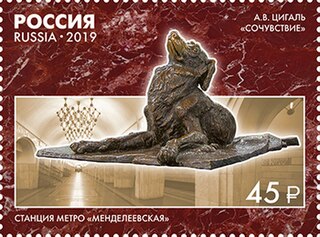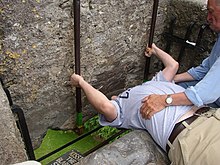
A kiss is the touch or pressing of one's lips against another person or an object. Cultural connotations of kissing vary widely. Depending on the culture and context, a kiss can express sentiments of love, passion, romance, sexual attraction, sexual activity, sexual arousal, affection, respect, greeting, peace, and good luck, among many others. In some situations, a kiss is a ritual, formal or symbolic gesture indicating devotion, respect, or a sacramental. The word came from Old English cyssan, in turn from coss.

A herma, commonly herm in English, is a sculpture with a head and perhaps a torso above a plain, usually squared lower section, on which male genitals may also be carved at the appropriate height. Hermae were so called either because the head of Hermes was most common or from their etymological connection with the Greek word ἕρματα, which originally had no reference to Hermes at all. The form originated in ancient Greece, and was adopted by the Romans, and revived at the Renaissance in the form of term figures and atlantes.

A black cat is a domestic cat with black fur that may be a mixed or specific breed, or a common domestic cat of no particular breed. The Cat Fanciers' Association (CFA) recognizes 22 cat breeds that can come with solid black coats. The Bombay breed is exclusively black. All-black fur pigmentation is slightly more prevalent in male cats than female cats. Most black cats have golden irises due to their high melanin pigment content.

Juliet Capulet is the female protagonist in William Shakespeare's romantic tragedy Romeo and Juliet. A 13-year-old girl, Juliet is the only daughter of the patriarch of the House of Capulet. She falls in love with the male protagonist Romeo, a member of the House of Montague, with which the Capulets have a blood feud. The story has a long history that precedes Shakespeare himself.

Il Porcellino is the local Florentine nickname for the bronze fountain of a boar. The fountain figure was sculpted and cast by Baroque master Pietro Tacca (1577–1640) shortly before 1634, following a marble Italian copy of a Hellenistic marble original, at the time in the Grand Ducal collections and today on display in the classical section of the Uffizi Museum. The original, which was found in Rome and removed to Florence in the mid-16th century by the Medici, was associated from the time of its rediscovery with the Calydonian Boar of Greek myth.
"Rabbit rabbit rabbit" is a superstition found in Britain and North America wherein a person says or repeats the words "rabbit", "rabbits" and/or "white rabbits" aloud upon waking on the first day of a month, to ensure good luck for the rest of it.

Gregory of Nin was a Croatian Catholic prelate who served as a medieval Bishop of Nin and strongly opposed the pope and official circles of the Catholic Church. He introduced the Croatian language in the religious services after the Great Assembly in 926, according to traditional Croatian historiography. Until that time, services were held only in Latin, not being understandable to a majority of the population. Not only was this important for Croatian language and culture, but it also made Christianity stronger within the Croatian kingdom.

Russian traditions and superstitions include superstitions and folk rituals of the Russian community. Many of these traditions are staples of everyday life, and some are even considered common social etiquette despite being rooted in superstition. The influence of these traditions and superstitions vary, and their perceived importance depends on factors such as region and age.

A touch piece is a coin or medal believed to cure disease, bring good luck, influence people's behaviour, carry out a specific practical action, etc.

Everard t'Serclaes, Lord of Kruikenburg was a citizen of Brussels who was made famous by his recovery of the city from the Flemings. His brother, Jean, was bishop of Cambrai.

Many societies have traditions which involve kissing. Kissing can indicate joy or be used as part of a greeting. Kissing involves the touching of one's lips to the lips or other body part, such as the cheek, head or hand of another person. Sometimes people often kiss their friends as a way of giving luck or even showing feelings.
Sir Francis Sharp Powell, 1st Baronet was an English Conservative politician who sat in the House of Commons between 1863 and 1910.

The Loggia del Mercato Nuovo, popularly known as the Loggia del Porcellino, is a building in Florence, Italy. It is so called to distinguish it from the Mercato vecchio that used to be located in the area of today's Piazza della Repubblica.

Malchik was a black mongrel stray dog living in Moscow, Russia. For about three years, Malchik lived at the Mendeleyevskaya station on the Moscow Metro. In 2001, he was killed when a 22-year-old woman, Yuliana Romanova, stabbed him with a kitchen knife. The incident sparked a wave of public outrage regarding the treatment of animals, and, in 2007, a monument was erected in Malchik's honour at Mendeleyevskaya station.

John Harvard is a sculpture in bronze by Daniel Chester French in Harvard Yard, Cambridge, Massachusetts honoring clergyman John Harvard (1607–1638), whose deathbed bequest to the "schoale or Colledge" recently undertaken by the Massachusetts Bay Colony was so gratefully received that it was consequently ordered "that the Colledge agreed upon formerly to bee built at Cambridg shalbee called Harvard Colledge." There being nothing to indicate what John Harvard had looked like, French used a Harvard student collaterally descended from an early Harvard president as inspiration.

The Greyfriars Bobby Fountain is a granite fountain in Edinburgh, surmounted by a bronze life-size statue of Greyfriars Bobby, a Skye Terrier who became known in 19th-century Edinburgh for supposedly spending 14 years guarding the grave of his owner John Gray until the dog itself died on 14 January 1872.

The Karl Theodor Bridge, commonly known as the Old Bridge, is an arch bridge in Heidelberg that crosses the Neckar river. It connects the Old City with the eastern part of the Neuenheim district of the city on the opposite bank. The current bridge, made of Neckar sandstone and the ninth built on the site, was constructed in 1788 by Elector Charles Theodore, and is one of the best-known landmarks and tourist destinations in Heidelberg.

A wedding is a celebratory ceremony where two people are brought together in matrimony. Wedding traditions and customs differ across cultures, countries, religions, and societies in terms of how a marriage is celebrated, but are strongly symbolic, and often have roots in superstitions for what makes a lucky or unlucky marriage. Superstition is often linked to practices involving luck, fate or prophecy, and while many weddings are now more focused on celebratory traditions, many are still practiced, and numerous well-known wedding traditions have roots in superstitions from previous ages. A common example of a superstition involves no one seeing the bride in her wedding dress until the ceremony.

A colossal bust of Abraham Lincoln was made by Gutzon Borglum and completed in 1908. The original marble sculpture is installed in the United States Capitol crypt, in Washington, D.C. Reproductions cast in bronze are installed in several other locations, including the Lincoln Tomb in Springfield, Illinois.


















